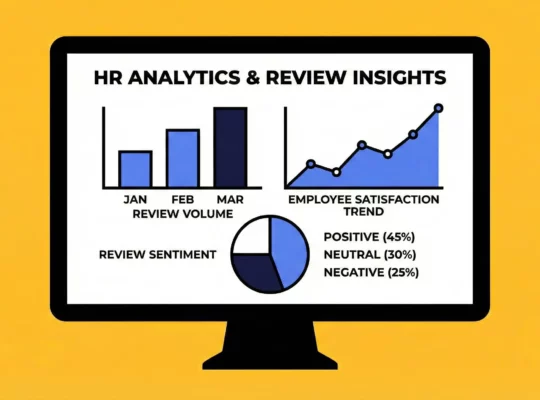Corporate storytelling isn’t just a marketing technique. It’s the art of sharing meaningful, personal, and authentic experiences that resonate with your team, leadership, and wider audience. Whether you’re talking about your company’s humble beginnings or an employee’s growth journey, each story has the power to influence, inspire, and connect.
At Review.jobs, we know that transparency fuels trust—and the best way to provide that transparency is through stories told by real people in real time. After all, Candidates trust the company’s employees 3x more than the company to provide credible information on what it’s like to work there. Employee reviews are one of the most powerful storytelling tools a company can leverage—not only for recruitment, but for strengthening the emotional connection with both internal and external audiences.
This article explores what corporate storytelling means, how it differs from traditional brand messaging, and why it’s one of the most effective communication tools available. We’ll walk you through practical storytelling techniques, examples from leading brands, and how you can use platforms like Review.jobs to highlight employee experiences that make your organization stand out.
Table of Contents
- The Overlap Between Corporate Storytelling and Employee Reviews
- Employee Reviews as a Corporate Storytelling Medium
- Leveraging Review.jobs to Fuel Your Storytelling Strategy
- How to Use Reviews to Tell Your Company Story
- Best Practices for Story-Driven Review Management
- Final Thoughts – Let Employees Tell the Story
The Overlap Between Corporate Storytelling and Employee Reviews
What Is Corporate Storytelling in a Business Context?
Corporate storytelling is the strategic sharing of a company’s journey, values, and purpose through narrative structure. This includes everything from the brand’s origin story to stories about innovation, challenge, growth, and triumph.
Traditionally, storytelling in business was driven from the top—crafted by leadership teams and polished by PR. But that’s changing fast. Now, companies are recognizing that some of the most compelling corporate stories come from within, told by the people who experience them firsthand: employees.
Where Employee Reviews Fit Into the Corporate Narrative
Think of employee reviews as digital storytelling—short-form, personal, and full of emotion. They offer real-time, unfiltered, first-person accounts of the employee experience. These reviews either validate or challenge the organization’s stated values, mission, and internal communication strategies.
A strong brand narrative hinges on authenticity, and nothing reveals the truth behind a company culture quite like an employee’s lived experience. These stories become the litmus test for whether a company’s brand identity is more than just a marketing message.
Trust and Credibility Through Authentic Voices
Trust is the currency of communication, and employee reviews are gold. Candidates trust the company’s employees 3x more than the company to provide credible information on what it’s like to work there. Job seekers, customers, and even shareholders also turn to employee stories to better understand how a business really operates.
That level of trust means reviews don’t just support your message—they become the message. They add emotional connection, context, and credibility to words like “belonging,” “inclusion,” or “flexibility.” They humanize corporate language and create space for real, relatable storytelling.
Employee Reviews as a Corporate Storytelling Medium
What Makes an Employee Review a Story?
Not every review is a story—but every story can start with a review. To transform employee reviews into compelling corporate storytelling, look for:
- Setting: The environment, department, or role where the story takes place
- Conflict or Challenge: Workload issues, cross-functional collaboration, skill-building obstacles
- Resolution: Leadership support, team innovation, personal growth, or a change in policy
- Emotion and Perspective: How the experience made the employee feel
It’s this narrative structure—setting, conflict, resolution, and emotion—that makes stories resonate.
Highlighting Core Values Through Real Experiences
Employee reviews can be treasure troves of values-driven stories. For example:
- A junior employee sharing how leadership stepped in during a period of burnout demonstrates a commitment to wellbeing and management care.
- A team describing how they were encouraged to test a risky new idea? That’s innovation in action.
These aren’t abstract values written in a handbook—they’re lived values told in real people’s words. And they offer more power than any corporate presentation.
Turning Review Themes Into Culture Narratives
When multiple reviews surface the same themes—like inclusivity, career growth, or flexibility—that’s not a coincidence. That’s your company’s unofficial narrative being written in real time.
Here’s how to make use of it:
- Identify repeating themes across departments, locations, or teams
- Craft content that reflects these truths—use quotes, highlight trends, build real-life case studies
- Align your internal and external messaging around these themes to keep your brand consistent
This is storytelling goodness: patterns told by your people, packaged with strategy.
Leveraging Review.jobs to Fuel Your Storytelling Strategy
Why Review.jobs?
Review.jobs is more than just a platform—it’s your storytelling partner. Built to help companies manage the entire review process, it makes it easy to collect, display, and act on employee feedback. And because it’s focused on authenticity, you get quality stories—not just quantity.
Whether you’re a marketing leader crafting your company story or an HR professional looking to improve culture through transparency, Review.jobs gives you the tools you need to build trust and inspire action.
Key Features That Enhance Corporate Storytelling
| Feature | What It Does | Storytelling Benefit |
| Custom Review Forms | Tailor prompts to spark culture-rich feedback | Surfaces meaningful stories |
| Live Review Showcases | Embed employee reviews on public pages | Turns your site into a storytelling platform |
| Sentiment Analysis | Identify recurring emotions and themes | Helps shape your brand story |
| Moderation Tools | Filter harmful content without altering tone | Preserves authenticity while maintaining respect |
| Branding Integration | Pair reviews with culture videos and team spotlights | Builds a multi-layered narrative |
Elevating the Employee Voice with Review.jobs
With the right tools, your employees become brand ambassadors—not just by title, but through their stories. Review.jobs empowers them to:
- Share their own story in their own voice
- Contribute to an honest, evolving corporate narrative
- Inspire future employees and deepen engagement with current ones
Storytelling for business starts here—with your people and the truth they share.
How to Use Reviews to Tell Your Company Story
Internally
Employee reviews aren’t just for external branding—they’re powerful tools for internal connection and cultural alignment. When used with intention, reviews can help reinforce values, foster a sense of belonging, and inspire positive change from within. Here’s how to use storytelling with reviews to build a stronger internal culture:
1. Share Standout Reviews in Team Newsletters or Town Halls
Every company has moments of excellence—why not let your people tell those stories? Highlighting authentic, positive employee reviews during internal meetings or in team newsletters puts the spotlight on real experiences.
- Feature quotes from recent reviews that reflect team wins, leadership growth, or workplace culture highlights.
- Rotate departments or voices to ensure everyone sees themselves reflected in the company’s evolving story.
- Consider adding a “Review of the Month” segment during all-hands meetings to celebrate team contributions and foster pride.
This reinforces a culture of appreciation and creates a feedback loop where employees feel heard and valued.
2. Use Review Insights to Drive Management Improvements
Internal reviews often surface patterns—some uplifting, others eye-opening. Instead of viewing criticism as a red flag, treat it as a compass pointing toward meaningful growth.
- If multiple reviews mention communication gaps, explore new channels or leadership training.
- Positive trends (e.g., “supportive team culture” or “transparent leadership”) can be reinforced and used as internal best practices.
- Share anonymized review themes with managers to encourage reflective leadership and proactive problem-solving.
In short: mine the data, not just for metrics, but for momentum.
3. Reinforce Values by Pairing Employee Reviews with Leadership Commentary
When leaders echo and respond to employee experiences, it builds trust and cohesion. Try pairing reviews that reflect company values (e.g., innovation, collaboration, respect) with short notes or recorded responses from executives.
- A glowing review about team collaboration? Have your COO comment on how that aligns with the company’s mission.
- A review that shows concern about work-life balance? Let leadership acknowledge it and share upcoming support initiatives.
This not only shows that leadership is listening—it demonstrates a culture of shared ownership and accountability.
Externally
When it comes to attracting top talent, employee reviews act as powerful social proof—real voices from real people validating what it’s like to work at your company. Today’s job seekers are doing their homework:
📌 52% of candidates visit a company’s website or social media before applying.
This behavior gives you a clear opportunity: turn that curiosity into connection by putting authentic employee experiences front and center. Here’s how to do it:
1. Showcase Employee Quotes on Careers Pages
Forget generic promises—give candidates a window into actual employee experiences.
- Pull direct quotes from verified reviews that highlight team culture, career growth, leadership support, or day-to-day wins.
- Use images of your employees (with permission) to make it even more human.
- Highlight a rotating set of voices across functions and seniority levels to show diversity of experience.
This builds trust from the first click and reinforces your employer brand without needing to say, “We’re a great place to work.” Your people say it for you.
2. Build Review-Based Campaigns Around Mentorship, Growth, or DEI
Job seekers want more than a paycheck—they’re looking for purpose, belonging, and growth. Use employee reviews to spotlight the aspects of your culture that matter most:
- Create mini-campaigns that feature reviews centered around mentorship or internal promotions.
- Share DEI-focused reviews to illustrate inclusion from the inside out.
- Turn review content into carousel posts, video clips, or short-form stories for platforms like LinkedIn and Instagram.
This kind of storytelling positions your company as more than a workplace—it becomes a community.
3. Create “Story Clusters” Around Common Review Themes
Are multiple reviews praising leadership transparency? Or maybe work-life balance keeps coming up? Use these consistent themes to your advantage.
- Organize reviews into clusters (e.g., “Career Development,” “Team Support,” “Innovation Culture”).
- Turn each cluster into a storytelling series across your platforms—blog posts, emails, social media, or internal spotlights.
- Include relevant metrics or outcomes when possible (e.g., retention rates, promotion stats) to add context and credibility.
This helps you shape a cohesive, multidimensional brand narrative built on patterns—not cherry-picked praise.
Best Practices for Story-Driven Review Management
To craft an effective corporate storytelling strategy using reviews, follow these practices:
- ✅ Ask open-ended questions that invite personal storytelling
- ✅ Encourage submissions at key milestones—onboarding, promotions, project completions
- ✅ Never suppress criticism. Instead, respond with transparency
- ✅ Track story arcs across departments and time
- ✅ Collaborate with marketing to amplify high-impact stories
Remember, storytelling isn’t a department—it’s a business strategy.
Final Thoughts – Let Employees Tell the Story
Your company culture isn’t what you say it is. It’s what your people say it is.
That’s why employee reviews are so powerful—they are your corporate story, told in real time, with real emotion, by real people. By integrating them into your storytelling strategy, you build a brand that not only speaks but also resonates.
With Review.jobs, you have a certified platform to manage, scale, and celebrate the authentic stories that drive culture, attract talent, and build trust—one review at a time.





